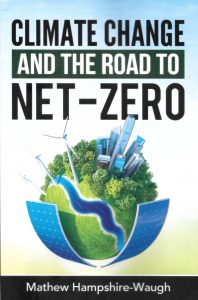The one-sentence summary
We need to break down the engrained idea that fossil fuels are cheap and zero carbon is expensive – this is not the case.
Can’t be bothered to read it? Too much screen time lately? Listen to the 5-minute podcast in two parts.
WHAT THE BOOK SAYS 
- This book uses the conflicting narratives of increasing prosperity and our reconfiguring of the natural world to explore the science, economics, technology and politics of climate change. It explodes the entrenched idea that solving global warming requires a trade-off between the economy and the environment and reveals why a twenty-year transition to a zero carbon system is a win-win for all.
- The fundamentals that underpin climate change forecasts can be adjusted to create drastically different outcomes. These are science, economics and technology – what the author calls the three sensitivities, or the dials of doom and boom. They are:
- Climate sensitivity: a science-based value which governs how quickly temperature will change based on our loading it with CO2.
- The discount rate: an economic factor that defines how much value we ascribe to future generations. The equations can be complicated. Dial this economic sensitivity up and damages seem small, manageable and distant; dial it down and climate change threatens prosperity and creates dangerous tipping points.
- The experience curve: the technological rate of learning which predicts how quickly zero carbon solutions become cost competitive. The idea that prices decline with accumulated experience is vital to understanding the economics of a net-zero transition. For example, the costs of lithium-ion storage batteries decline 30% every time production doubles, and wind costs decline 10% every time installed capacity doubles.
- As planetary caretakers, there are three strategies to address climate change:
- Adaptation: letting the world warm and living with change.
- Climate engineering: reducing deforestation, reforestation, ocean nutrition etc.
- Mitigation: assumes prevention is better than cure. This approach can be examined using an equation called the Kaya Identity, which states that emissions of greenhouse gases are the product of population, GDP per person, energy efficiency and emissions intensity.
- Specifically, reengineering the transport system for peak travel and zero carbon would cost the world up to 40% less than sticking with our current oil-based system. Reengineering industry in the same way would cost 25% less. For amenities such as residential and commercial space, the figure is 10% cheaper.
- Agriculture is more complex. There would need to be a sensible mix of all options, including switching a third of beef and lamb consumption to fish, chicken or pork, reducing waste by a third, improving crop yields by a third and deploying low carbon technology over a third of all farming.
WHAT’S GOOD ABOUT IT*
- We should be moving as fast as we can to push the 80% of commercial technology down in cost and develop a range of options for the last 20% to diversify and de-risk the final push. A fast transition will give the best economic outcome. The ambitions of the Paris agreement need to be tripled, the actual rate of supply side change must move five times faster and demand must electrify ten times faster.
- A full-scale zero-carbon energy system is 25% cheaper than the fossil fuel equivalent. Energy supply in a zero carbon world would involve:
- Electricity becoming more than 70% of final energy. Final energy is the total energy consumed by end users, such as households, industry and agriculture. It is that which reaches the final customer’s door and excludes that used by the energy sector itself.
- Fossil fuels declining to less than 20% (from 80%).
- Hydrogen and Biomass providing 10% each.
- Getting to net-zero will require $70 trillion of upfront investment ($46tn more than sticking with fossil fuels) but it will create an energy system that is $5.5tn cheaper to run each year. The $1.5tn of investment in fossil fuels needs to be pushed into net-zero solutions. The $500bn of fossil fuel subsidies needs to be reduced.
- Humans are risk averse. They like to win, but they hate to lose. This is why climate change is such a divisive issue. Those campaigning for immediate action fear the implications of a warmer planet. Those still in favour of fossil fuels fear the social or economic cost of changing our energy system.
- There are four fairly straightforward routes of action: electrify everything, push for net-zero, reduce meat and dairy, and reduce unnecessary consumption.
*Many of the points are clearly not ‘good’.
WHAT YOU HAVE TO WATCH
- This is a serious academic book running to 400 pages, and so could be too much work for the casual reader.
- Also, despite a huge number of helpful diagrams, it would have been good to see a visual depiction of the three dials in their various states.
